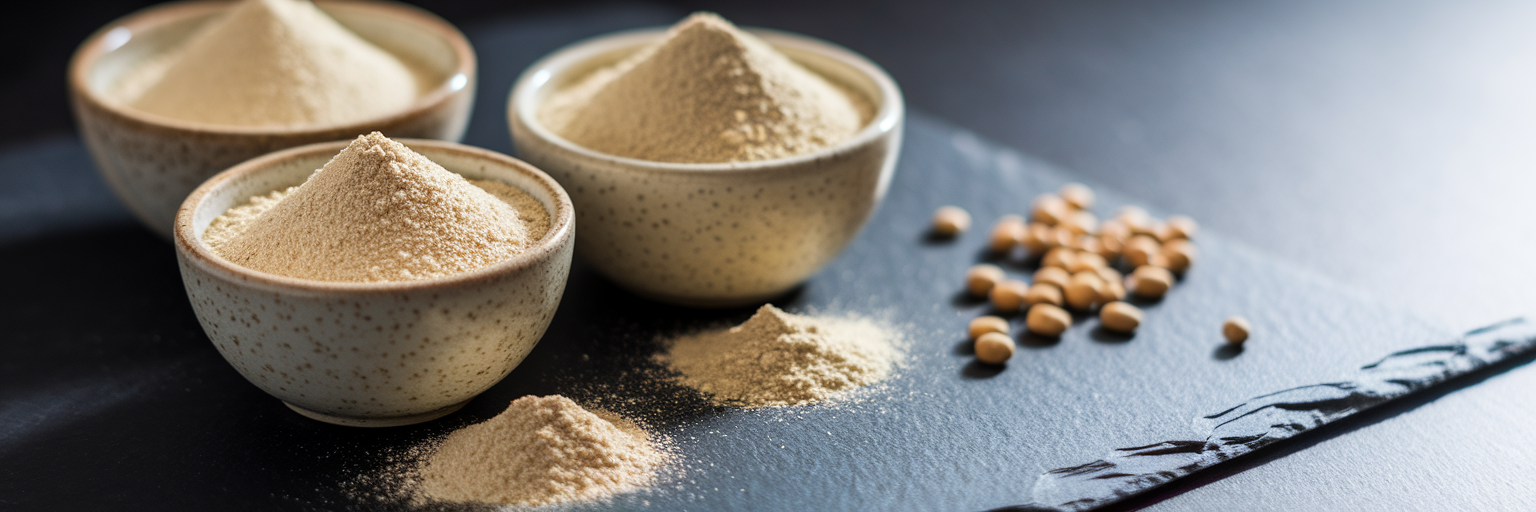We’ve all been there. You mix up your morning protein shake, take that first hopeful sip, and then… grit. That chalky, sandy texture is an all too common experience for anyone using plant-based protein. It’s a frustrating moment that can make you want to abandon your health goals altogether. If you’ve ever wondered, why is my protein powder chalky, you’re not alone, and there’s a simple reason for it.
Unlike whey protein, which dissolves easily in liquid, plant proteins come from sources with larger, more irregular particle structures. Think of it like trying to dissolve coarse sand versus fine powder in water. The plant fibers and starches naturally resist dissolving, leading to that unpleasant mouthfeel. This isn't a personal failure with your shaker bottle; it's a characteristic of the raw ingredients.
But here’s the good news: a gritty shake is not a requirement for a plant-based lifestyle. The difference between a chalky powder and a creamy one comes down to thoughtful sourcing and advanced manufacturing. A great texture is not just a luxury; it’s what makes your daily protein habit sustainable. After all, if you don't enjoy drinking it, you're not going to stick with it.
The Gritty Reality of Plant-Based Protein
That moment you take a sip of a freshly mixed protein shake, only to be met with a chalky, gritty texture, is universally disappointing. It’s a common complaint, and it’s the number one reason people give up on a vegan protein powder. You’re not just imagining it, and it’s not your fault. The core of the issue lies in the fundamental structure of plant proteins.
Unlike whey, which is highly soluble, plant protein sources like peas, rice, and hemp have larger, more fibrous particles that don’t dissolve as easily in liquid. This is the simple answer to the question, why is my protein powder chalky? It’s the natural state of the plant material. Without proper processing, these particles remain suspended in your drink, creating that sandy mouthfeel that makes a shake feel like a chore to finish.
However, this is where quality makes all the difference. Forward-thinking brands understand this challenge and invest in sourcing and processing methods designed specifically to overcome it. The journey from a gritty powder to a smooth, enjoyable shake begins long before the tub reaches your kitchen counter. It starts with choosing the right ingredients and refining them with intention. Texture is the foundation of consistency; if you dread drinking your protein, you’re far less likely to use it regularly and see the results you’re working toward.
The Science Behind a Silky Smooth Shake

So, if plant proteins are naturally less soluble, how do some brands achieve that creamy, milkshake-like consistency? The secret isn’t magic; it’s a combination of smart science and thoughtful formulation. It’s about what happens at the manufacturing level to transform a coarse ingredient into a refined, smooth powder. Understanding these steps helps you appreciate what makes some of the best protein powders we've reviewed stand out.
Advanced Processing Methods for a Finer Powder
Top-tier manufacturers use techniques like ultrafiltration and micro-milling to refine the protein. Think of it like a baker sifting flour. Sifting removes clumps and creates a finer, more uniform powder that mixes seamlessly into a cake batter. Similarly, these advanced filtering methods separate the larger, grittier starches and fibers from the protein molecules, resulting in a powder with a much smaller particle size that dissolves more completely.
The Power of Multi-Source Protein Blends
You’ll often notice that premium powders use a blend of different plant proteins, such as pea, fava bean, and pumpkin seed. This isn't just for nutritional variety. Each protein source has a unique molecular shape. By combining them, formulators can create a more complex and complete protein matrix where smaller particles fill the gaps between larger ones. This synergy results in a denser, creamier texture that a single-source protein often can't achieve on its own.
Helpful Ingredients That Enhance Texture
If you see ingredients like guar gum or xanthan gum on a label, don’t be alarmed. These are plant-derived, soluble fibers that act as natural thickeners and stabilizers. A tiny amount helps bind the protein and liquid together, preventing separation and adding a pleasant creaminess. They are the unsung heroes of a smooth shake, helping to create a consistent texture from the first sip to the last.
Why Higher Protein Concentration Can Mean Smoother Results
It might seem counterintuitive, but a powder with a higher protein concentration per scoop is often smoother. This is because the intensive filtering required to boost the protein content simultaneously removes more of the non-protein elements, like starches and fibers. These are the main culprits behind a gritty texture. So, a cleaner, more concentrated protein is not just more potent; it’s typically smoother, too.
Choosing Your Protein Source for the Best Texture
While processing plays a huge role, the type of plant protein used is the foundation of a powder's texture. Knowing the general characteristics of each source can help you scan an ingredient list and predict how your shake will turn out. Some proteins are simply born smoother than others.
For those seeking the smoothest vegan protein powder, fava bean protein is a standout. It has an exceptionally fine particle size and a neutral flavor, making it a prime ingredient for creating a creamy, non-gritty shake. It’s a key component in what many consider the best tasting plant based protein blends. Close behind is pea protein, a reliable and widely used option that is generally smooth and mixes well, though its quality can vary between brands.
On the other end of the spectrum, some proteins are known for being texturally challenging. Rice protein, for example, is notorious for its tendency to be gritty or chalky. Hemp protein has a distinctively earthy, slightly sandy texture that works best when masked by other ingredients in a thick smoothie. As a recent report from Nutraceuticals World highlights, formulators are increasingly turning to sources like fava and pea to improve the mouthfeel of plant-based products, confirming that ingredient choice is critical.
When you're shopping, look for fava or pea protein listed high on the ingredient panel. Better yet, opt for a multi-source blend that leverages the strengths of each to create a superior final product.
| Protein Source | Typical Texture Profile | Flavor Profile | Best For |
|---|---|---|---|
| Fava Bean Protein | Exceptionally smooth, creamy | Very neutral, slightly savory | Those prioritizing a milkshake-like texture above all. |
| Pea Protein | Generally smooth, can be creamy | Mildly earthy or vegetal | A reliable, all-around choice for daily shakes. |
| Hemp Protein | Slightly gritty, earthy | Nutty and distinct | Blending into smoothies with strong flavors like berries or chocolate. |
| Rice Protein | Can be noticeably gritty or chalky | Slightly sweet, can be bland | Those who need a hypoallergenic option and don't mind extra blending. |
Note: Texture can vary significantly based on the brand's processing quality. This table reflects general characteristics of each protein source.
Your At-Home Guide to a Creamier Shake

Even with a high-quality powder, your preparation method can make a world of difference. If you’re still struggling with texture, a few simple adjustments in your kitchen can dramatically improve your experience. Here is your guide on how to make protein shakes less gritty using what you already have.
- Upgrade from the Shaker Bottle: A shaker bottle is convenient, but it’s no match for stubborn plant protein particles. A blender is your best friend. The high-speed blades are far more effective at breaking down the powder and integrating it fully into the liquid, creating a vortex that emulsifies the mixture into a smoother state.
- Blend for Longer Than You Think: Most people blend for about 10 to 15 seconds and call it a day. Try blending for a full 30 to 45 seconds. This extra time allows the powder to fully hydrate and dissolve, breaking down any remaining clumps and resulting in a noticeably creamier consistency.
- Add a Touch of Healthy Fat: Fat is a natural emulsifier and adds a luxurious creaminess. A spoonful of cashew or almond butter, a quarter of an avocado, or a splash of coconut cream can transform your shake’s texture from watery to velvety.
- Choose Your Liquid Wisely: Water is hydrating, but it does nothing for creaminess. Opt for a plant-based milk instead. Oat milk is famously creamy, while soy milk offers a protein boost and a smooth finish. Almond milk is a lighter option but still provides more body than plain water.
By incorporating these simple steps, you can take control of your shake’s final texture. For more inspiration, you can explore some of the easy vegan protein recipes we've created that are designed for both taste and texture.
How to Read Protein Labels Like a Texture Expert
Walking down the supplement aisle can be overwhelming, but now you have the knowledge to make an informed choice. Reading the label is your final step to ensuring you bring home a powder you’ll love. Here are a few key vegan protein powder texture tips to look for on the packaging.
- Look for Multi-Source Blends: As we discussed, a blend of proteins like pea, fava bean, and pumpkin seed is often a sign of a well-formulated product designed for a superior texture. A single-source powder, especially from rice or hemp, is more likely to be gritty.
- Don’t Fear the Gums: If you see a small amount of guar gum or xanthan gum on the ingredient list, view it as a positive. It shows the formulator was paying attention to mouthfeel and actively worked to create a smoother, more stable shake.
- Check for Quality Indicators: While not directly related to texture, certifications like USDA Organic and Non-GMO Project Verified often signal a brand’s overall commitment to quality. A company that invests in premium, certified ingredients is also more likely to invest in the advanced processing needed for a better texture.
- Prioritize Fava and Pea Protein: Scan the ingredients list. If you see fava bean or pea protein listed as one of the first ingredients, you’re on the right track for a smoother experience.
A thoughtfully designed powder, like our Chocolate Vegan Protein, is created with these principles in mind, balancing high-quality protein sources with ingredients that ensure a delicious and smooth result every time.
Your New Approach to Plant-Based Protein
Finding a vegan protein powder you genuinely look forward to drinking is not about luck; it’s about knowledge. A gritty, unpleasant shake doesn’t have to be your reality. By focusing on the three key pillars, you can guarantee a better experience.
First, choose the right protein source, prioritizing naturally smooth options like fava bean and pea. Second, read the label like an expert, looking for multi-source blends and signs of quality processing. And third, use the right techniques at home by blending your shake longer and with creamier liquids.
A smooth, delicious protein shake is completely achievable. It’s not a sacrifice you have to make for your health goals. Now that you know what to look for, you can choose with confidence.
If this guide helped you, consider sharing it with a friend who has the same complaint! Or, feel free to explore our full collection of thoughtfully formulated products to find your new favorite.



